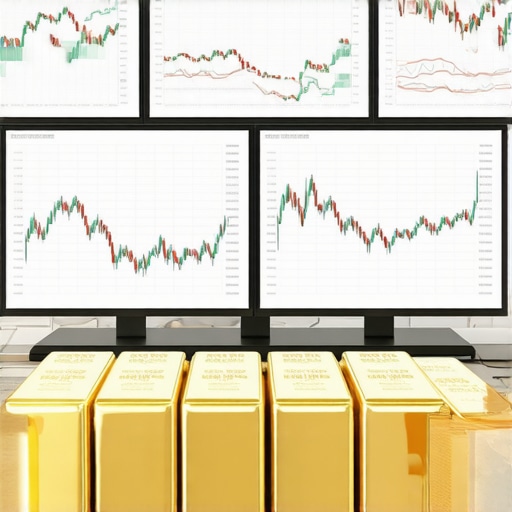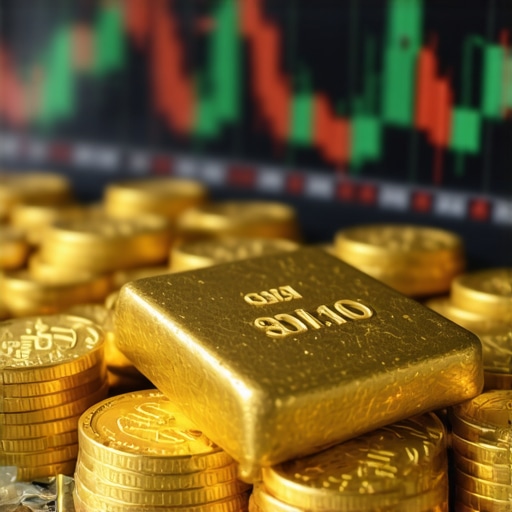Understanding the 2025 Gold Price Forecast: Key Trends and Factors
As we approach 2025, investors and analysts alike are keenly observing the dynamics of the gold market. Gold has traditionally been a safe haven, especially during economic uncertainty, making its price movements crucial for many investors. In this article, we will delve into the current trends shaping the gold market and provide insights into what factors may drive prices in the upcoming year.
Gold prices are influenced by a myriad of factors, including global economic conditions, inflation rates, and central bank policies. With many economies still recovering from the impacts of the COVID-19 pandemic, the demand for gold as a hedge against inflation and currency fluctuations is expected to remain strong. Investors looking to navigate these turbulent waters may find it beneficial to explore the role of gold in economic uncertainty.
Current Market Trends Influencing Gold Prices
Recent trends indicate a growing interest in gold investments, particularly among retail investors. The rise of gold ETFs has made it easier for individuals to invest in gold without having to purchase physical assets. This shift is significant as it broadens the market base, allowing for increased demand and potentially higher prices. For those new to investing, investing in gold ETFs presents a modern approach to diversifying one’s portfolio.
Moreover, geopolitical tensions around the globe often lead to increased gold prices as investors seek safety. As we look ahead to 2025, factors such as trade wars, political instability, and changes in global leadership could affect market sentiment and demand for gold. For instance, central banks remain major players in the gold market, with their purchasing decisions impacting prices significantly.
Impact of Inflation and Economic Policies
Inflation rates are another critical factor influencing gold prices. With many countries experiencing elevated inflation levels, gold is often viewed as a reliable hedge. Investors who are concerned about rising prices may look to gold as a stable investment option. Understanding how inflation impacts gold prices can provide investors with a clearer strategy for their portfolios. For more insights, consider reading Understanding Gold as a Hedge Against Economic Downturns.
Another aspect to consider is the monetary policies enacted by central banks worldwide. Interest rates, bond yields, and quantitative easing measures can all affect the attractiveness of gold as an investment. For those looking to understand how these policies shape the gold market, exploring how gold prices correlate with global economic events can be quite enlightening.
As we prepare for 2025, staying informed about these trends and factors will be essential for any investor looking to capitalize on the potential of gold. Whether you’re a seasoned investor or just starting, understanding the complexities of the gold market can help you make informed decisions. Keep an eye on the evolving landscape, and remember to check back for updated analyses and insights on gold market trends.
Understanding Gold Demand Trends: Key Influencers for 2025
In the evolving landscape of gold investment, understanding the demand trends is crucial for any investor looking to navigate the market effectively. Demand for gold is influenced by various factors, including cultural practices, technological advancements, and economic shifts. For example, in many countries, gold is not only a form of investment but also a vital part of cultural and religious ceremonies. This cultural significance can sustain demand even during economic downturns. To explore the broader implications of gold demand, check out Gold Demand Trends: Analyzing the Current Landscape.
The Role of Gold in Investment Portfolios
Investors are increasingly recognizing the importance of diversifying their portfolios, and gold has become a key component in this strategy. The role of gold in diversifying portfolios cannot be overstated, especially in times of economic uncertainty. Gold often moves inversely to stocks and bonds, making it a reliable hedge against market volatility. For those interested in how to effectively incorporate gold into their investment mix, consider reading Investing Wisely: The Role of Gold in Diversifying Portfolios.
Geopolitical Factors Affecting Gold Prices
Geopolitical tensions are another significant factor that can influence gold prices. As global events unfold, investors often flock to gold as a safe haven, causing prices to rise. For instance, ongoing conflicts or trade disputes can lead to increased demand for gold. Keeping an eye on geopolitical developments can provide valuable insights into potential price movements. For further reading on this topic, you may want to explore How Economic Changes Shape Gold Demand Patterns.
Strategies for Evaluating Gold Investment Opportunities
Identifying the right gold investment opportunities requires a thorough understanding of the market. Investors should consider various strategies, including analyzing market trends, understanding historical price movements, and assessing the potential risks involved. For those new to gold investment, How to Invest in Gold for Beginners: A Simple Guide offers essential tips and insights.
Exploring Gold Investment Vehicles
There are multiple ways to invest in gold, each with its own set of advantages and disadvantages. From gold bullion and gold coins to gold ETFs and gold mining stocks, understanding the various investment vehicles can help investors make informed decisions. Each option presents unique risks and returns, and knowing the differences can significantly impact overall investment performance. For a comprehensive comparison, check out Gold Bullion vs. Gold Coins: Which is the Better Investment?.
Importance of Research and Market Analysis
Conducting thorough research and market analysis is vital for successful gold investment. Investors should stay updated on global economic indicators, market trends, and expert analyses to make informed decisions. Resources such as Gold Market Analysis: Current Trends and Future Predictions can provide valuable insights into the future of gold prices.
As we approach 2025, the gold market presents numerous opportunities and challenges. By staying informed about trends, understanding the factors influencing prices, and employing effective investment strategies, investors can better position themselves in the gold market. Whether you’re looking to invest in gold for the first time or are a seasoned investor, the knowledge gained from these insights will prove invaluable in navigating the complexities of gold investment.
Evaluating Gold Investment Risks: A Comprehensive Overview
Investing in gold comes with its own set of risks and opportunities that every investor should understand. One significant risk is market volatility, as gold prices can fluctuate widely based on economic factors and investor sentiment. This volatility can affect short-term investments, but many consider gold a safe haven for long-term stability. Understanding these investment risks is critical for anyone looking to profit from gold. For more insights into managing these risks, explore Evaluating Gold Trading Risks and Mitigation Strategies.
Market Volatility and Its Impact on Gold Investments
The market volatility of gold can be influenced by numerous factors, including geopolitical tensions, inflation rates, and changes in currency values. For instance, when the U.S. dollar weakens, gold typically becomes more appealing to investors. This inverse relationship means that fluctuations in currency can significantly affect gold prices. Keeping abreast of global economic developments is essential for anticipating these changes. To delve deeper into how economic shifts impact gold prices, consider reading How Gold Prices Fluctuate: Key Influencers to Watch.
Understanding Gold Investment Vehicles
When evaluating gold investment opportunities, it’s crucial to understand the various vehicles available. Investing in tangible assets like gold bullion and gold coins offers the advantage of physical ownership, but these options come with storage and insurance costs. Alternatively, gold ETFs provide a more liquid investment option without the need for physical storage. However, ETFs carry their own risks, such as management fees and market fluctuations. For a detailed comparison of these investment types, check out Gold ETFs vs. Gold Mutual Funds: Which to Choose?.
Utilizing Gold as a Hedge Against Economic Uncertainty
Gold has long been viewed as a hedge against economic uncertainty. In times of recession or inflation, many investors turn to gold to preserve their wealth. Understanding how to leverage gold in your portfolio can provide significant advantages. For those considering retirement options, Gold Investment for Retirees: Safe and Profitable Options offers valuable strategies.
Gold as a Safe Haven Asset During Market Downturns
During periods of financial instability, gold often retains its value better than stocks and bonds. This quality makes it a popular choice among risk-averse investors. For example, during the 2008 financial crisis, gold prices soared as investors sought refuge from falling stock prices. Understanding the dynamics of gold as a safe haven asset can help you make informed decisions during market downturns.
Assessing Global Economic Indicators
Global economic indicators play a critical role in shaping gold prices. Key indicators include inflation rates, employment figures, and interest rates. Higher inflation typically leads to increased gold demand as investors seek to hedge against declining purchasing power. Monitoring these indicators can provide insights into when to buy or sell gold. To stay updated on market trends, consider resources like Gold Market Analysis: Current Trends and Future Predictions.
In conclusion, evaluating gold investment risks and opportunities is essential for building a robust portfolio. By understanding market dynamics, the various investment vehicles available, and the broader economic indicators, investors can position themselves strategically in the gold market. Whether you are a novice or an experienced investor, maintaining awareness of these factors will significantly enhance your investment decisions and potential returns.
Maximizing Gold Investment Returns: Strategies for Success
To truly capitalize on gold investments, employing effective strategies is paramount. Understanding how to navigate the complexities of the gold market can significantly enhance your returns. Whether you are investing in gold bullion, coins, ETFs, or stocks, having a well-defined strategy tailored to your financial goals will help you optimize your portfolio. If you’re new to gold investment, consider reading How to Invest in Gold for Beginners: A Simple Guide for foundational insights.
Diversification: Balancing Your Gold Investments
Diversification is a key principle in investing that helps mitigate risks while maximizing returns. In the context of gold, this means incorporating various types of gold investments into your portfolio. For example, combining physical gold like coins and bullion with gold ETFs and mining stocks can create a balanced approach. This strategy allows you to take advantage of different market conditions. To learn more about diversifying your gold investments, check out Gold Stocks and Mutual Funds: Diversifying Your Portfolio.
Timing Your Gold Investments
Timing can greatly influence the success of your gold investments. Monitoring market trends and economic indicators is crucial. Recognizing when to enter or exit the gold market can maximize your returns. Investors often look for signals such as rising inflation or geopolitical instability as potential indicators of when to invest in gold. For a comprehensive overview of how to analyze gold market trends, consider reading How to Analyze Gold Market Trends for Profitable Choices.
Understanding Gold Demand Trends: Important Factors
Gold demand trends are influenced by various factors ranging from economic conditions to cultural significance. Understanding these trends can provide insight into when and how to invest in gold effectively. For instance, during economic downturns, demand for gold often spikes as investors seek safe-haven assets. Similarly, cultural factors, such as gold’s significance in weddings and festivals in countries like India, can drive demand. To explore these dynamics further, read Gold Demand Trends: Analyzing the Current Landscape.
The Role of Central Banks in Gold Demand
Central banks play a pivotal role in gold demand and prices. When central banks increase their gold reserves, it often signals a lack of confidence in fiat currencies, which can drive gold prices higher. Monitoring central bank purchases can provide valuable insights for investors. Understanding how these purchases impact gold prices today can be critical for strategic investment decisions. For more information, consider checking out How Central Bank Gold Purchases Impact Prices Today.
Global Economic Indicators and Their Impact on Gold Prices
Economic indicators like inflation rates, interest rates, and employment figures directly influence gold prices. For example, high inflation often leads to increased gold demand as investors seek to protect their purchasing power. Interest rate fluctuations also play a significant role; lower interest rates typically encourage gold investment as the opportunity cost of holding gold decreases. Staying informed on these indicators can enhance your ability to make timely investment decisions. To stay updated on these factors, refer to Understanding Gold Demand: Key Factors to Watch.
Conclusion: Positioning Yourself for Gold Investment Success
In conclusion, maximizing returns on gold investments requires a multifaceted approach that includes risk evaluation, strategic diversification, and a keen understanding of market dynamics. By leveraging gold as a hedge against economic uncertainty and staying informed about demand trends and global economic indicators, you can position yourself for success in this precious metal market. Whether you’re a beginner or an experienced investor, applying these strategies will enhance your ability to navigate the complexities of gold investing and ultimately increase your investment returns.
Frequently Asked Questions About Gold Investment
What are the best types of gold investments?
The best types of gold investments depend on your financial goals and risk tolerance. Common options include physical gold (bullion and coins), gold ETFs, gold mining stocks, and mutual funds that focus on gold. Each type has its benefits and risks, so it’s vital to evaluate them according to your investment strategy.
How does gold serve as a hedge against inflation?
Gold is traditionally viewed as a hedge against inflation because it tends to retain its value when currency values decline. As inflation rises, the purchasing power of cash diminishes, prompting investors to turn to gold as a stable asset, thereby increasing demand and price.
What factors influence the price of gold?
Several factors influence gold prices, including economic indicators (inflation rates, interest rates), geopolitical events, central bank policies, and market demand. Staying informed about these factors can help investors make timely decisions regarding their gold investments.
How can I analyze gold market trends?
To analyze gold market trends, investors should monitor key economic indicators, global events, and historical price movements. Tools like technical analysis and fundamental analysis can also provide insights into potential future price movements. Resources like How to Analyze Gold Market Trends for Profitable Choices can be helpful in this regard.
Is it better to invest in physical gold or gold ETFs?
The choice between physical gold and gold ETFs depends on your investment strategy and preferences. Physical gold can offer tangible value and security but requires storage and insurance. Gold ETFs provide liquidity and ease of trading without the hassles of physical ownership. Each option has its pros and cons, so consider your circumstances.
What is the historical performance of gold as an investment?
Historically, gold has demonstrated resilience during economic downturns and periods of high inflation. While it may not always provide high returns compared to equities over the long term, it often serves as a safe-haven asset that can help preserve wealth. Understanding historical performance can guide future investment decisions.
Can gold investments provide passive income?
While gold itself does not generate income like dividends or interest, investors can achieve passive income through gold mining stocks or mutual funds. These investments can provide returns in the form of dividends or capital appreciation, depending on the performance of the underlying assets.
How do central bank policies affect gold prices?
Central bank policies significantly impact gold prices. When central banks increase their gold reserves, it often indicates a lack of confidence in fiat currencies, leading to higher gold prices. Conversely, when they sell gold or reduce reserves, it may lead to lower prices. Monitoring central bank activities can offer insights for investors.
What are the risks associated with gold investing?
Gold investing carries several risks, including market volatility, geopolitical tensions, and changes in interest rates. Additionally, physical gold investments require considerations related to storage and security. Understanding these risks is crucial for making informed investment decisions.
Where can I find authoritative resources on gold investment?
Authoritative resources on gold investment can be found through financial news websites, government publications, and investment firms specializing in precious metals. Websites like the World Gold Council and Investopedia provide valuable information on gold trends, market analysis, and investment strategies.
Summary: Navigating Gold Investment with Confidence
In summary, maximizing returns on gold investments requires a comprehensive understanding of market dynamics, effective strategies, and risk management. By answering common questions related to gold investing, we can reinforce the necessity of informed decision-making. Whether exploring the types of investments, understanding price influences, or recognizing the significance of diversification, knowledge is key to success in the gold market. By applying these insights, investors can confidently navigate the complexities of gold investing and position themselves for success.










